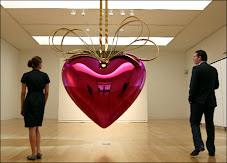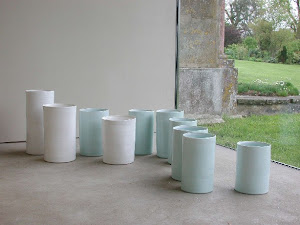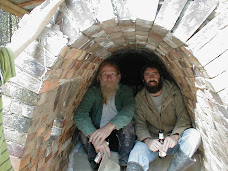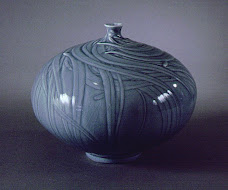If I could have any ceramic piece in the world, I would most likely request this bowl. I think that the Kizaemon Edo tea-bowl is a representation of our human connectection to mother earth, to our infinate universe, and of our seeking something higher. It's hi(story) makes it one of the most important vessels in Japan. I have an attraction to this tea-bowl because of it's rough surface, it's use in spiritual practices in Japan, and because of what other's have said about it. If I did have this bowl I would probably not use it - in order to preserve it as well as possible.
In his book The Unknown Craftsman: A Japanese Insight into Beauty, Soetsu Yanagi discusses the The Kizaemon Tea-bowl, a bowl made in Korea in the 16th century and selected by Japanese Tea masters in the early 17th century to be used as an artifact in the Tea ceremony:
This single Tea-bowl is considered to be the finest in the world. . . . to contain the essence of Tea. . . .In 1931 I was shown this bowl in company with my friend, the potter Kanjiro Kawai. For a long time I had wished to see this Kizaemon bowl. I had expected to see that "essence of Tea," the seeing eye of Tea masters, and to test my own perception; for it is the embodiment in miniature of beauty, of the love of beauty, of the philosophy of beauty, and of the relationship of beauty and life. It was within box after box, five deep, buried in wool and wrapped in purple silk.When I saw it, my heart fell. A good Tea-bowl, yes, but how ordinary! So simple, no more ordinary thing could be imagined. There is not a trace of ornament, not a trace of calculation. It is just a Korean food bowl . . . that a poor man would use everyday. . . .A typical thing for his use; costing next to nothing . . . an article without the flavour of personality; used carelessly by its owner; bought without pride; something anyone could have bought anywhere and everywhere. . . . The kiln was a wretched affair; the firing careless. Sand had stuck to the pot, but nobody minded; no one invested the thing with any dreams. It is enough to make one give up working as a potter. . . .But that was as it should be. The plain and unagitated, the uncalculated, the harmless, the straightforward, the natural, the innocent, the humble, the modest: where does beauty lie if not in these qualities? The meek, the austere, the unornate—they are the natural characteristics that gain man's affection and respect.More than anything else, this pot is healthy. Made for a purpose, made to do work. Sold to be used in everyday life. . . . Only a commonplace practicality can guarantee health in something made. . . .Emerging from a squalid kitchen, the Ido bowl took its seat on the highest throne of beauty. The Koreans laughed. That was to be expected, but both laughter and praise are right, for had they not laughed they would not have been the people who could have made such bowls . . . The Koreans made rice bowls; the Japanese masters made them into Tea-bowls. . . .
Tuesday, September 25, 2007
Tuesday, September 18, 2007
Flower Container
This "Flower Containter" was made by Kitaoji Rosanjin in the mid-1900's. It was lent to the Denver Art Museum by John and Celeste Fleming in 1972. Rosanjin lived from 1883-1959. I was attracted to this piece originally because of it's rough, less refined look. I have had an attraction to Japanese ware for some years now, and it was nice to see this example of Rosanjin's work. Since my connection with ceramics that is very related to my history as a cook, I was intrigued to say the least when I heard of his history. Rosangin was an accomplished chef, and a calligrapher when he was young. In 1923 an earthquake ddestroyed his collection of antique wares in his third restaurant, Hoshigoaka, in Tokyo. He began working with clay this year, with the intention of replacing the broken pieces. This became a lifetime passion for Rosangin. The flower container I looked at was a stoneware piece which was glazed and fired using an older method, possibly in an anagama kiln. The form had an imperfect, yet perfect feel. The vase had a somewhat sloppy glaze application, rough incise marks, and a lip and foot which matched in that they were both finished in a quick manner. I could see rib marks on in the fired clay, clearly exhibiting the methods used. Rosanjin was largely self-taught, but he surely looked closely at other Japanese work from his day as well as from the past. the glaze used dripped all the way down to the bottom of the piece - even to form (accidental?) feet. The feeling I get when I look at this piece is a free feeling. The form and the glaze being imperfect mimic something from nature which is perfectly imperfect. This vessel radiates organic inspiration; bare clay, iron spots, etc. The way in which the glaze runs looks like the way water can stain stone with time. All of these things I could bring into my work, but I find it hard because I am currently trying to clean up my forms and glazing techniques. I could see the intention of the artist, which was to make fine ceramic vessels. I wish I could see flowers in the container.
Thursday, September 6, 2007
Comments on Paul Greenhalgh’s lecture, at Alfred University, 2001.
I appreciate Greenhalgh’s ideas and his understanding of modernity.
I like what he said about all ceramic vessels having many sources and roots, even if unknown to the artist.
So, there was Modern Art, and the idea of modernity had much to do with progress.
This is wonderful, for we would not want to be in a stagnant world with stagnant arts, though I don’t believe this was ever true.
Modernist ceramics? Post modern? Complex modernism? What is next?
I make post, post, post modern cups.
“How can there be an “after” when there was no during” Paul asked.
This is a good question. Why is there a need for such extensive categorization?
Do artists or art historians feel like we need to move into a new era every ten years?
Concerning the questions presented about economic value, there can be no standard cost of ceramic, as there is for gold. That is absurd. The value of a ceramic object, as well as the social function, is relative to the socio-economic environment of the society who holds it. Within ceramics lie many functions and styles. I do not believe in one ceramic function, style or economic value. It should not be such an issue to find ceramic’s place in art history, or contemporary art. I am tired of these questions. I am tired of hearing ceramic artists feeling like they have to prove themselves, or fight their way into the “high-art” world. Just as common is a disassociation with the craft world, which is primarily what ceramics still is today.
I don’t care if ceramics ever gets the privilege of being part of modernism.
I appreciate Greenhalgh’s ideas and his understanding of modernity.
I like what he said about all ceramic vessels having many sources and roots, even if unknown to the artist.
So, there was Modern Art, and the idea of modernity had much to do with progress.
This is wonderful, for we would not want to be in a stagnant world with stagnant arts, though I don’t believe this was ever true.
Modernist ceramics? Post modern? Complex modernism? What is next?
I make post, post, post modern cups.
“How can there be an “after” when there was no during” Paul asked.
This is a good question. Why is there a need for such extensive categorization?
Do artists or art historians feel like we need to move into a new era every ten years?
Concerning the questions presented about economic value, there can be no standard cost of ceramic, as there is for gold. That is absurd. The value of a ceramic object, as well as the social function, is relative to the socio-economic environment of the society who holds it. Within ceramics lie many functions and styles. I do not believe in one ceramic function, style or economic value. It should not be such an issue to find ceramic’s place in art history, or contemporary art. I am tired of these questions. I am tired of hearing ceramic artists feeling like they have to prove themselves, or fight their way into the “high-art” world. Just as common is a disassociation with the craft world, which is primarily what ceramics still is today.
I don’t care if ceramics ever gets the privilege of being part of modernism.
What is this?
Does it, or could it enrich an environment?
What does it look like?
Is it beautiful?
How has time changed this object?
If there was a reason, why was it made?
With what tools was this made?
With which materials, and why? Does the material add to the value or meaning of the object?
Would I like to look at it, have it, or own it?
Is there a contemporary equivalent?
Why am I attracted/ or not to this object?
How was this made?
How long did it take?
Could I make this, replicate this, or would I want to?
Who made it? When? Why? Where?
What was this used for, or what should it be used for?
Did it/ does it have a function other, religious or otherwise?
Is this the original? If not, how many were made?
Is there a visual narrative, or iconic information?
What was the role of the object for the creator?
How much does that weigh?
What does the bottom look like, the back?
Why did the artist/craftsperson make this object?
Who were the artists’ teachers, if any?
Why did they choose the colors, and shape, visual content?
Who was this for, and who paid for it to be made?
Could it be used in the same way today?
Did just one person make this?
Does this relate to other objects?
What is its worth? To whom? Has this changed with time?
Would I use it?
Is its intended use obvious?
What is its relationship to the human body, seemingly or literally?
Is this considered art? And was it when it was made?
Does this matter?
Does this have a title? Or background information about the artist?
Which culture produced this?
Where was the artist in his/her career? Education?
Does it, or could it enrich an environment?
What does it look like?
Is it beautiful?
How has time changed this object?
If there was a reason, why was it made?
With what tools was this made?
With which materials, and why? Does the material add to the value or meaning of the object?
Would I like to look at it, have it, or own it?
Is there a contemporary equivalent?
Why am I attracted/ or not to this object?
How was this made?
How long did it take?
Could I make this, replicate this, or would I want to?
Who made it? When? Why? Where?
What was this used for, or what should it be used for?
Did it/ does it have a function other, religious or otherwise?
Is this the original? If not, how many were made?
Is there a visual narrative, or iconic information?
What was the role of the object for the creator?
How much does that weigh?
What does the bottom look like, the back?
Why did the artist/craftsperson make this object?
Who were the artists’ teachers, if any?
Why did they choose the colors, and shape, visual content?
Who was this for, and who paid for it to be made?
Could it be used in the same way today?
Did just one person make this?
Does this relate to other objects?
What is its worth? To whom? Has this changed with time?
Would I use it?
Is its intended use obvious?
What is its relationship to the human body, seemingly or literally?
Is this considered art? And was it when it was made?
Does this matter?
Does this have a title? Or background information about the artist?
Which culture produced this?
Where was the artist in his/her career? Education?
Subscribe to:
Posts (Atom)
.jpg)











